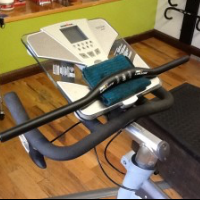I want to thank Robyn Stricoff, who attended our IC Instructor Insight Webinar on hand position, for this great question:
“Do you cue about 30% body weight on handlebars when out of saddle to prevent dumping and to make sure people have enough gear under their feet?”
There is a lot of confusion concerning how much force/weight we place on the handlebars when out of the saddle. This confusion also extends to the perceived “core” workout one receives while riding. In this article I will touch on both. Needless to say, the combination of physics, kinesiology, functional anatomy, and strength training principles that could be discussed would make for a very lengthy response. We’re going to keep it short (relatively) and shoot right to the point.
What Percentage of Our Body Weight Should Be Placed on the Handlebars When Standing?


I use the cue “light as a feather” not only regarding weight on the handlebars but also with regard to not stomping up the hill….think “light as a feather”.
Excellent article. Especially the notes regarding the “core”. As an outdoor cyclist and an indoor instructor, I understand completely your examples. Now, to take this knowledge to my class, especially since I am sandwiched between classes that ask participants to “suck in the tummy” to engage the core and to “pull on the handlebars” along with other silly movements. May get in trouble with “management” AGAIN!!
Thanks Karen, you are in good company (getting in trouble with management). Stick to your guns. Anyone who questions sound science should not involved in group fitness nor indoor cycling program and should stick to what they do….managing. It is a tough line to tow sometimes as we end up in conflict with many other instructors. Just smile 🙂
Jennifer, I just did the same thing, I tried to “like” your “like button” comment. LOL
@Sara, I keep looking for the Facebook “Like” button to Like your comment!
I’ll agree with Jennifer here. I see all too many times in a standing climb with new (to me) riders that their legs will be pumping fast but their full weight is on the bars. It’s almost painful to watch – head down, elbows locked and wrists turning white from the pressure, legs churning stiffly. I’ll casually make my way over, smile sweetly and say “relax your upper body; shift your weight over the pedals more” and I will gently touch their lower back and elbow to guide where their weight should be. Usually works well with the men. 😉
yes, that’s a very real concern Tom. When a rider is told they have too much weight on the handlebars (or they perceive they are being told they have too much weight forward) you’ll notice them perching on their fingertips or the distal part of the metacarpals. Sometimes it’s pretty obvious, other times you’ll have to look close to see it. They might be pushing away from the bars with their thumbs as well. Let them know that they should wrap their hands around the bars, with full contact of the palms, not just partial contact.
If in fact they do have too much weight, it’s usually a matter of a very slight shift in weight towards the rear. Therefore, making the correction should not happen in the hands, by pushing away, but by the shifting the hips and torso back just a bit. The correction is often very subtle.
I just want to make sure we don’t swing the pendulum in the other direction causing riders to back off from applying the necessary pressure on the handlebars. Even though I was only placing 10-20% of my body weight on the bars (and I’m a light rider [technique] inside and on the road), this still equates to 20-30 pounds of pressure. If we encourage people to go too light on the handlebars, this will result in changes in alignment, and more concerning, inappropriate activation of core muscles to stabilize the upper body.
I like to say, “pretend that you have water balloons under your palms. When you stand, you’re going to squish them a little bit…but don’t pop them!”
The “feel” cue I use to impart the right feeling of weight in the hands is “as you are riding in the standing position, I should be able to put my hands under your hands, and your hands should be light enough to where I can easily slide my hands out from under your hands”.
Extra points to me for using “hands” 6 times in a sentence.
From experience the hands should feel the same from a pressure perspective regardless of position: seated v. standing.
I love your quantitative approach, Tom. Your set-up might be a very useful tool for motivated kinaesthetic learners. The feedback from the scale could let them get a better sense of what they are doing with their body and find a more correct alignment.